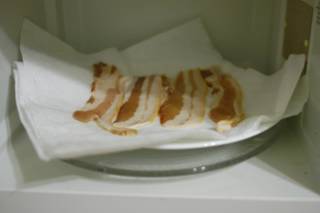 For my experiment, I took two slices of bacon and cut them in half. Placing them on three paper towels on a dinner plate, I slipped it into a microwave oven.
For my experiment, I took two slices of bacon and cut them in half. Placing them on three paper towels on a dinner plate, I slipped it into a microwave oven.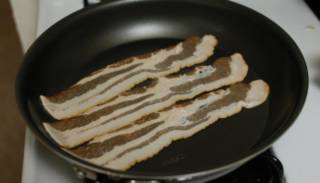 I also placed three strips of bacon on a large frying pan.
I also placed three strips of bacon on a large frying pan.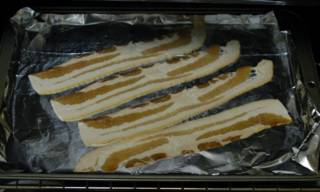 Finally, I spread out four strips on an aluminum foil lined baking sheet (for ease of clean up).
Finally, I spread out four strips on an aluminum foil lined baking sheet (for ease of clean up).Method 1: Microwaving
I ran the microwave on high for 3 minutes. After three minutes, I checked to see if the bacon was done (should be crispy). In my case, it was. If it's not done, give it another 30 seconds and look again. Repeat until crispy. Nothing could be easier.
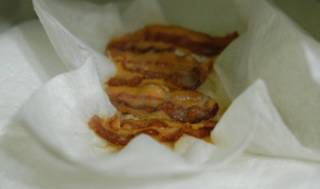
Related Articles
I placed the cold pan with bacon over a medium-low heat. The heat should be high enough that it cooks the bacon, but low enough that you can cook the bacon for a long time without burning it. If the bacon starts to look like it's going to burn (little bits of black start forming at the edges), turn down the heat. Cooking the bacon over low heat will render the most amount of fat out of the bacon. If the fat collects too much (1/4 in. depth), then spoon off the excess fat. Since I was only cooking three strips, there wasn't much danger of this.
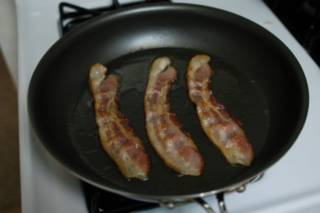
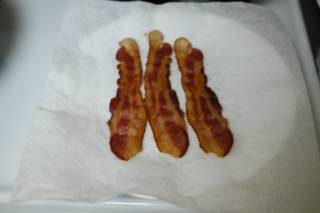 Keep turning the bacon over to evenly cook both sides. When the bacon reaches a deep brown color, it's done. Mine took about fifteen minutes.
Keep turning the bacon over to evenly cook both sides. When the bacon reaches a deep brown color, it's done. Mine took about fifteen minutes.Method 3: Broiler
After placing the baking sheet directly under the broiler, I turned it on. Every couple minutes, I pulled out the rack and flipped the bacon over.
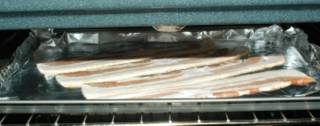
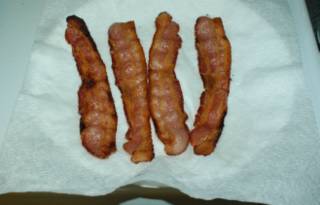 Unfortunately, it was very difficult to control the cooking of the bacon under the broiler. As the bacon curled up, the fat started to scorch and burn. After about eight minutes, I pulled it from the oven to prevent the rest of the pieces from burning.
Unfortunately, it was very difficult to control the cooking of the bacon under the broiler. As the bacon curled up, the fat started to scorch and burn. After about eight minutes, I pulled it from the oven to prevent the rest of the pieces from burning.Conclusions
Microwaved - The bacon came out extremely crisp throughout both the fat and meat of the bacon. It felt a bit thicker than I expected from a thin cut piece of bacon. Examining the fat collected in the paper towels leads me to believe that very little fat was rendered out in comparison to the pan fry method. The technique is simple and hands free, but a problem that I have is that the paper towel stuck to several of the pieces of bacon. This may have been because I allowed the bacon to rest and drain on the same paper towel it was cooked on. Another issue is the limited number of bacon strips you can cook in a microwave oven at one time (but the time savings probably more than makes up for this).
Pan fried - The bacon felt the thinnest and lightest of the three. The bacon fat was crispy while the meat was slightly chewy. I actually prefer my bacon this way (not totally crunchy and crispy, but with some texture to it), but others may not. All in all, a good method to cook bacon but time consuming.
Broiled - The bacon was burnt in some spots and the meat felt undercooked. The areas need the burns were bitter in taste and the texture was soft and soggy throughout (except for the blackened parts). Not much fat was rendered off either. I would not recommend this technique.
So, microwaving is king if you're looking for bacon that feels thicker than what you purchased and crunchy throughout. Pan frying is great for a thin, light bacon with a little chew in the meat.
In the future I will test other methods of cooking bacon including baking on a rack (a favorite for many). For now I need to recover from eating nine slices of bacon in an evening. (See Cooking Tests: Bacon (Part II) for more ways to cook bacon.)
An aside: Earlier in this article, I cooked the bacon directly on some paper towels. There might be some possible health concerns when doing this. There was once a popular internet chain mail scam/hoax claiming that microwaving Saran Wrap (or other plastic wraps) will release a chemical contaminant called dioxin into the food you are cooking. This was not true if you are using plastic or plastic wrap products labelled microwave safe (in the United States) as these do not contain any dioxins. A supporting e-mail later went on to encourage the use of paper towels instead for microwaving. As part of the backlash against this e-mail hoax, it was put forth that using paper towels might contribute more dioxins into your diet because the bleach used to produce paper towels contains chlorine and chlorine and wood form dioxins. There are plenty of websites that claim that dioxins are formed during the production of the paper towel or that microwaving creates dioxins, but I haven't found one that doesn't make a scientific error in their claim or discussion of the process. To my knowledge, dioxin is produced during combustion, which is not a part of the paper towel making process. The conclusion? I don't know. The Federal Drug Administration (FDA) just says to use products marked microwave-safe.
Related Articles

And 15 minutes sounds about right for pan fry. Do like Emeril says and use the adjustment knob and set it to medium. Keep your eye open for lean bacon at the market!
-ryan
http://theryanking.com
-Nik (dakan AT flashmail DOT com)
Will try your method, then maybe I will see some consistency in my bacon cooking.
For an unparalleled breakfast-meat experience, try brushing the bacon strips with a little real maple syrup before baking.
Great experiment, got a good feel for cooking methods and textures and evenness of cooking. One Question, which one tasted the best? I have tried them all and found that i like the taste of slow fried bacon the best.
I felt that the flavor produced by the microwaved bacon and pan fried bacon were similar. The texture contributes to how you feel when you eat it, so for my the pan fried bacon was the best given that it was not hard and crispy all the way through.
Philip
yum.
For the record, Bacon should only ever be fried, best in a little olive oil or pork fat (handy if you're planning on cooking sausages as well).
The exception to the rule is bacon joints, which should be boiled in (weak) brine.
From the CfE glossary: To cook food directly under the heat source. Typically refers to placing food immediately under an oven broiler.
Most ovens (at least in America) have a broil function where the flame comes from above allowing you to place food directly under the heating element. Other ovens only have one heating element (at the bottom) and have a tray where you broil below the heating element.
Broil = Grill depending on which part of the world you live in.
Microwave your bacon between two paper plates to overcome the paper towel problem, also one less dishe to clean.
Grilling == Bar-be-queing/Char-grilling;
Broiling == Grilling;
Gotta love i18n
I cook the bacon for 2-3 minutes on high power and then turn the cooker plate 180 degrees. After using the microwave for several years, I can gauge the time needed to finish the cooking depending on doneness at this time.
The downside to using the microwave, IMO, is that the bacon comes out almost too crisp vs. using a frying pan. Pros are the speed of cooking, ease of cleanup, and straight strips when cooked.
Cook's Illustrated has an article on cooking bacon in the oven. This is a subscription magazine, but, maybe this link will work to see the article. They use a little different approach than our host did in his test which obviates burning the bacon, but, is a bit work intensive compared to the microwave. Here is the link
http://www.cooksillustrated.com/article.asp?did=476
Baking bacon gives superior results to pan frying, it saves your sckin (no grease splatters), it requires less active work time for the cook, an entire package can be made on one baking sheet and it doesn't stink up the house as much.
Trust me, one package or bacon spread out on a jelly roll pan in a 350 oven is the way to go.
This way you only need to do the big messy clean up once in a while.
I must have a small microwave oven... The largest pyrex container that I can fit is an 8 in. square. My bacon is 12 inches long... There's no way I can fit 1 lb. of bacon in the pyrex dish without stacking. Do you microwave them stacked?
Everything but the squeal...
Is the "paper stick" factor reduced by cooking it at 50% power instead of 100%? Is there a desirable change in texture? eg: less crispy; more chewy?
We use the trick of using two plates together: 1 dinner plate, and a smaller side plate.
Upturn the side plate in the middle of the dinner plate, and drape the bacon on the bottom of the side plate (which is now facing up).
The bacon cooks; the grease drains down the sideplate and is caught by the dinner plate.
We also use a piece of kitchen roll over the top (so it doesn't spit everywhere) and voila!
PS: It's an idea to intermittently open the microwave and unstick the kitchen roll from the bacon.
temps in C not F please.
Unfortunately, here in the United States, most recipes are written using volumetric units for solids. I have been endeavring to provide the correct mass units as well in more recent articles, but haven't had the time to go back to fix the older articles.
Great site! I love to cook, and I love the layout of your recipes ... they make perfect sense!
The americans like crispy, streaked bacon.
Brits like bacon back and cooked not burnt.
Interesting article, but for me and most of the people i know, well we cook it in the pan or the grill (americans: broil). the biggest difference once the meat is cooked and the fat has coloured then it is ready. teh use of back bacon means that there is more meat less fat.
also crispy back bacon is not very edible.
The grease drains down below - where it can be collected for frying up stuff like home-fries - and the bacon lays straight and gets cooked. I like mine particularly crisp, so I let it cook for about 20 minutes at 350.
I have a smaller microwave, too - and my experience is that messing with paper towels and whatnot is a pain. Baking is just as fast as "slow frying," but without all the popping and splattering!
All of the fat drips off durring cooking, an amazin amount of fat actually.
http://www.makinbacon.com/cooking_with_the_dish.htm
So now I am back to the pan fry method of my pre-microwave days. This was taking me 15 minutes, too, in a cast iron skillet, but I figured out if you are only doing three or four strips, use a 9 inch teflon pan. Yes, it is too small for the bacon when you start out. You have to scrunch it in there a little. But, soon, the bacon shrinks to fit, out comes the fat and now you are "deep" fat frying. I can do four strips in about six to eight minutes. You did not mention to drain the bacon on paper towels to crisp it (it only takes 30 seconds longer), but I think this is key also. I like this bacon better than any microwave. And the teflon pan is easier to clean than the microwave tray.
My Dad alway used what he called a "bacon press", he made it out of a peice of stainless steal about 4"x8" and welded a handle to it. While the range was heating he would let the press sit on the range also, heating with it. Then when he placed the bacon on the range he would put the press on top of it, the bacon couldnt roll up because of the weight of the press.
tada, flat bacon :-)
I found a recipe this weekend for Amish peppered bacon.. it sounds bizarre, but also fabulous.. dip the bacon in egg, then coat it in a light coat of peppered flour, THEN fry. Doesn't end up with a thick coating, but is crisp and strange and different!
My arteries don't feel quite strong enough to try it yet...anybody feeling invincible? Let us know how it tastes!!
this way but fuctional
Clean brown paper bags can be used instead of paper towels.
Duane
LDA007@hotmail.com
I LOVE contact grilling my bacon & it's so much less messy & so much easier.
Baking has several advantages: Flatness; full rendering of fat; an even and rich browning; collectible fat with few particulates.
Method: 1) Use broiler pan with slotted top, or rack on baking sheet. (Slotted top is easier to clean).
2) To facilitate peeling of strips, microwave the 1 lb chunk: 3 pulses of 20 seconds, rotated.
3) A light spray of Pam or a swab with lecithin on pan helps prevent those curious bacon proteins from sticking.
3) Lay pieces on pan, overlapping 1 cm., as they will shrink. Center a "column" of ca. 10 strips down middle on X axis, then use 2 side areas for 2 strips each side on Y axis. This uses ca. 13 oz, leaving 4-6 strips for other uses. Trying to crowd the whole 16 oz in causes conjoined strips that are difficult to separate.
4) Oven should start at 350F, but turned down to 225-250 after 5 minutes (Standard anti-microbial technique). At 250 it will take about 40 minutes; 225 takes 60 minutes, etc. THE LOWER, THE BETTER for slow complete rendering. Going to 150 would be safe, if initial 350 "killzone" is observed.
5) Turning: In a NON-Convection oven there are two temp zones to observe: 1) the standard "hot spots" unique to each oven, and 2) the cooler center of mass vs the hotter perimeter of the pan. Thus, turning AND re-positioning (move from center cool to edge hot, and vice-versa) yields most even results. Use tongs and a teasing fork. Ideally, each piece gets 3 turns and rotations. Remember, the factory slicer is somewhat erratic, so each piece is unique in thickness. Check every 10-12 minutes if at 250. This is all not nearly as labor-intensive as it might sound.
6) Drain on a flat paper bag with single paper towel.
Pop it in the microwave for a minute, and you have perfect bacon when you hear that microwave go "ding!"
I used to be a skeptic of buying ready made bacon, but after trying this out, I wouldn't go back to cooking bacon. It seems to me that the people who make this product have more concerns about perfectly cooking the bacon, and they have executed accordingly.
The bacon tastes great. It is cooked throughout, and no matter how thin it is, it still has that crisp and chewiness that makes it the ideal bacon.
The only problem I have with is the greasiness. I think they flash freeze the bacon once they cook it, so the fat is kept. My husband gave me the perfect solution:
Place the bacon on top of rice when you pop it in the microwave. The fat runs down the rice and you'll have tasty rice and not-so-greasy bacon.
I guess this would be the solution if you like bacon on rice like we do. YUM. If not, then I'm sure the paper towel trick will do after letting it rest for a bit.
It's probably more pricey than raw bacon, but hey, if you're going to live it up by eating bacon, go all the way and get ready made bacon!
For perfectly flat bacon, I recommend using a clothes iron set on "linen" or whatever the highest setting is.
Place the bacon on parchment paper or yesterday's Times and have at it usng firm pressure to render the fat. Be sure the water reservoir on steam irons is empty, otherwise you will have difficulty reaching the proper temperature.
I will say that if you are at all meticulous about your appearance, (as you may be if you require ultra-flat bacon) you should probably use a separate iron from the one you use on your clothes. This technique is also handy for those late night BLTs after the bar closes when staying in a hotel, as most hotels supply an iron these days, but not a microwave or stove! I have not yet found a means of using a coffee-maker for cooking bacon. The hot plate just doesn't get hot enough.
3 - The microwave dish is easy to clean since the bacon wasn't browned.
Try Hormel Black Label pre-cooked.
Eat it cold or warm a few strips in the microwave for 30 seconds.
Mmmmmmm.
Yum!
The problem we have is...the bacon tastes different. We can got a side of hog and the first bacon was scrumptious. Months later we bought a bundle pack of beef, chicken and hog. The bacon tastes weird and smells weird while cooking. Not spoiled.
Different.
What is up with that?
Someone posted about brown paper bags. In the 50's & 60's the trend was brown paper bags for turkeys.
Now a days the paper has too many chemicals in it. So please do not cook in said bags..unless you like chemicals.
You can miss by a couple of minutes and repurpose the product to the next higher grade of crunchy... miss by 10 minutes and there will still probably be a some salvageable bits, depending upon your purpose and tolerance for carbon.
Next best: cast iron skillet with cover. Advantages: smells great, tasty seasoning for your skillet and the eggs you'll cook next, does not heat up the entire house in summer, leaves you with uesable bacon grease for other cooking tasks; a good system if you need not cook a great deal of bacon. Disadvantages: needs constant supervision, cooks more quickly than I think (unless I'm right on top of it I always get very crispy/carbon), bacon grease gets into the atmosphere and winds up everywhere in the house, especially the air cleaner filters
Unfortunately, (and probably because it was a good product) they don't make them anymore. Everyone switched to those ridiculous sandwich grills that "form" the sandwich into triangles.
Eventually (15 years or so) the grill burned out and was discarded.
Today I am toying with the idea of buying two large flat griddles and mounting them so I can press my bacon and cook both sides at once in the same fashion.
Bacon is probably my all time favorite meat and this is the best bacon I've ever tasted for texture, crispness, flavor, fat content, ease of cleanup (I could go on).
Most "flat" sandwich presses today don't have sides which actually press against each other. The idea being the sandwich would be too thin if compressed to 1/16 inch (1.58 mm).
If anyone knows of a product which presses completely together and has two sided flat grilling, please let me know: kevin13914@comcast.net
Thank you.
~MLE
microwaves?
ready cooked bacon?
If people who read this site really care about taste then these options should be thrown out the window without even trying them.
Microwaves are very good machines for heating food but cook things very badly (especially meat because they don't sear any of the juices). I've had bacon cooked in a microwave - it's floppy and chewy and insipid.
Next time you buy ready cooked bacon, look at the ingredients. If it's 100% pork, then go ahead and buy it, but remember it will never taste as good as the 'fresh' kind, in the same way that fish fingers don't taste like freshly caught cod.
As for frozen bacon - freezing meat breaks the molecular structure and ruins the taste AND the texture of the meat.
Cooking slowly in an oven, pan, under a grill or on a barbecue, however, all taste great (depending on how you like your bacon).
Thanks
Larry Hermann
MS Food Sci., U of Ill. 1978
Thanks,
John Burrage
Cooking the bacon at high temperatures might be the curprit. Try cooking your bacon in the oven at 200 - 300 degrees F and see if the bacon tastes any different.
Are you using nitrate free bacon? Sometimes the nitrates can also produce an off flavor when cooked at high temperatures. This is also generally believed to be unhealthy (may promote stomach cancers).
C
Sir, Read all the comments to your old orange juice article as of today.
I have a neighbor who is a Chef and a wife who is a follower of the dates on food products. I always argue with them about throwing out food from my refrigeratior. However, I let them toss what they want 95% of the time.
Years ago, I looked into the expiration date problem Look at the Federal government site and then look at other sites.
Your arfticle was one of the best that I have seen on the expiration problem.
I am pleased that you went to Tip Top. Thank you. JR Sligoe[/b:6aadbc08eb]
Other factors need to be considered, namely, the thickness of the cut. Thin baccon will come out crispier in general. Thicker baccon needs longer cooking at slightly diminished temperatures to make crispy.
I have one favorite way to cook bacon, in the frying pan but I have two favorite ways of preparing the bacon. before frying the bacon rinse it with fresh water then fry it, for some reason the bacon won't shrink in length near as much but you still get a crunchy/chewy bacon. the other way is to dredge the bacon in flour first, shake off as much flour as you can then fry it up. the flour will help the bacon stay flat and not curl and it decreases "shrinkage" it also adds a slightly different texture. take a bite of this bacon, chew it up good, swallow, now take a drink of coffee, this floured bacon can make any cup of coffee taste fantastic, it has the same effect on eggs and low calorie toast too I don't know why that is though.
The towel on top keeps the fat from splattering all over the microwave. The paper towels on the bottom soak up the fat which runs off the bacon. Since the fat runs off, the bacon renders VERY well. You can make it as soft or crispy as you like, by altering how long you cook it (I like it soft, the wife likes it crispy).
You end up with U-shaped pieces of bacon, but the sides are straight because gravity has kept them that way while it was cooking. No need for a bacon press.
This works pretty well. The bacon never sits in a pool of fat, so this definitely reduces the calories. And yet, you still get all the flavor.
After reading this forum through extensively, I felt the need for some dead pig ingestion myself, so i set up my brand new foremen grill in my dorm (not sure its supposed to be here, but thats not stopping me...)
Bacon is GREAT on a foremen grill. As long as the dorm mates dont mind the smell early in the morning, the grease is easily collectible in the runoff tray, and the 1/2 strips of bacon fit perfectly when cooked perpendicularly to the grill lines.
Good luck!
I found a summer method I love: Get a charcoal grill going for some other kind of lucky viand - and when the coals have ceased to become useful for meat-cooking, bung a few strips of Oscar Meyer thick=sliced on there.
Bacon results = crispy & delicious - no fat to clean up, and MMMM char-residue...
www.baconcleanlycooked.com
Nitrosamines are known to cause cancer in laboratory animals, when these substances are used to induce cancer, they are in much higher levels than that that bacon can produce....however, there is still much uncertainty as to how dangerous these compounds can be at levels produced by cooking bacon at high temperatures.
health officials in the united states, back in the 70's, because of this risk, require all prepackaged sliced nitrate/nitrite cured bacon to be treated with vitamin C (an antioxidant) which is known to neutralize Nitrosamines to a degree.
that said, if your smart, and consume nitrate/nitrite cured bacon or ham on a regular basis, your best off cooking either at a low temperature, under 300 degrees F.
Whether pan frying or cooking in the oven you can have great results with bacon at around 200F for several hours...the exact timing being heavily dependant on the intitial temperature of the bacon.
besides reducing the risk of cancer, there are a couple of other benefits of cooking in this manor, most of all the texture....when done right the resulting bacon is the perfect blend of chewiness and crispiness. Another being the low maintenance requirements....you CAN do other things around the house while cooking in this manor....and to top it all off, there is much less concern about air currents (leading to uneven cooking in the oven) or overcooking one side due to not flipping or even flipping at all...you dont need direct contact with the metal to cook in this manor, the bacon grease does the work.
the major drawback is that to justify the hours of waiting....your going to need to make alot of bacon at once....whether in the pan or the oven, i typically cook about 3-5 lbs at a time...it keeps for about a week or so in the fridge, provided you microwave it for a few seconds prior to consuming or can be stored in the freezer for 6 months or so.
some people like meat burnt...people are going to cook how they are going to cook, and I'm an example of that with chicken and beef on the grill and smoker.... I would just suggest that anyone who regularly injests foods that have visible charring, and in particular, foods that contain nitrates/nitrites also consume large amounts of antioxidants...it's not going to hurt you, and may just let you enjoy the foods you love a little bit longer.
Your pages on bacon are great. I just wanted to let you know that I linked to you from this page:
http://www.mahalo.com/How_to_make_perfect_bacon
Great stuff!
Nicole
Here's the ultimate bacon recipe.
I'd be tempted to plop it on an omelet then flip inside out . . .
but cheese is good <g>
E.g., 250F put a cookie sheet pressed down on top of your bacon on foil on its cookie sheet. With contact, cooks evenly, flat like pancake, so much better than micro. Takes a little longer, though.
Also, for extra flavour only butter one side of the bread. Place sauce on buttered side. Keep one slice of bread spare to dip in the fat after you're finished. This way you don't waste any flavour. Don't worry about calories, we're cooks not doctors.
this is the way ALL my family cooks bacon and im yet to find anyone who can challenge me on my bacon sarni skills.
It was on Barefoot Contessa today.
Tom
Just throwing that out there, and wondering if this is true / known. Why does something as good as bacon have to be so bad for you? Harumph.
ps Thanks for the experiments!
Around 400 degrees should be enough. Probably 7-10 minutes a side.
You may want to check out a butcher's for the choicest cuts of bacon (yummy, but more expensive). This way you will know the qualities of the premium bacon, and can look for the same qualities in the store-bought stuff. This applies to all meats in general though...I highly recommend becoming friends with a man/woman who can teach you about meat.
Also, as a fan of cooking and of good health, I highly advice people NOT to microwave anything. I've not used a microwave in over 7 years. Microwaved food is bad for your health. A quick google will confirm it. It's called "Microwave sickness" and happens when you nuke food, the protein strands get so big your kidney and liver have a difficult filtering it. If you love your kidneys and liver, don't nuke your food.
The only thing I use a microwave for are to nuke my sponges at the end of the day. Damp sponges 2 minutes on high. That's ALL a microwave should be used for.
Beware of "Teflon Flu" as they call it.
I only use 3 cooking items:
Cast Iron
Earthernware ~ unglazed, or if glazed, nothing with bright colors as it might contain mercury and other funky stuff you don't want.
Stainless Steel
Aluminum Sheet pan
Parchment Paper
13-17 cut Bacon (meaning 13-17 slices of bacon per pound)
1. Lay your bacon out with 1/2 inch between each piece, without stretching the meat and causing tearing. (Make sure your bacon is ice cold and not overly handled this will cause it to tear easily)
2. Refridgerate uncovered for 1 night to dehydrate the surface of the bacon, water being the naturally enemy of maillard reaction.
3. Cook the Bacon with low fan at 325 degree farenheit for 18-22 minutes depending on the quality of your oven.
4. When the bacon just starts to show caramel colors on the meat pull and allow to rest in a temperature controlled environment where it will not get cold.
If you have done this correctly the fat portions of the bacon should have a literal "melt in your mouth" quality, instead of stringy and nasty. The meat should be slightly crispy but not crunchy, Low moisture qualities in bacon can cause it to quickly turn into jerky if cooked at too high a temperature.
<b>That</b> is a fine observation!
I save the grease from the last time I cooked, (actually, several times) and melt it in a frying pan, enough grease to completely submerge the curled up bacon, and cook it to my liking. The bacon cooks evenly because it is totally submerged in the bacon grease. It is the best bacon ever, bar none.
To those that worry about how the bacon looks, seriously? THAT is what matters to you? Curled up, flat, looking like Michael Jordans collar? None of that really matters as long as the bacon tastes good.
On a side note, today as I was cooking my bacon I decided to speed the meal up by deep frying the breakfast sausage i was preparing to cook. Ummmmm, wow!!! The best ever.
Try it before you knock it!